Advanced Accounting 1: Analyzing Cost Allocation at CMI Safe Co
VerifiedAdded on 2023/06/05
|13
|2114
|401
Case Study
AI Summary
This assignment provides a detailed case study analysis of CMI Safe Co. and its cost allocation methods, specifically comparing traditional costing with activity-based costing (ABC). The report highlights the disadvantages of traditional costing, where costs are allocated based on a single cost attribute, potentially leading to inaccurate product costing and pricing. The document then explores activity-based costing as an alternative, allocating costs based on various cost drivers and actual usage of activities. Calculations are performed to determine the rate per activity and revise the income statement under ABC, revealing how traditional methods can distort product costs and profit margins. Ultimately, the case study demonstrates the importance of accurate cost allocation for informed decision-making and recommends that CMI Safe Co. adopt activity-based costing to ensure correct information for strategic decisions. Desklib provides similar solved assignments for students.
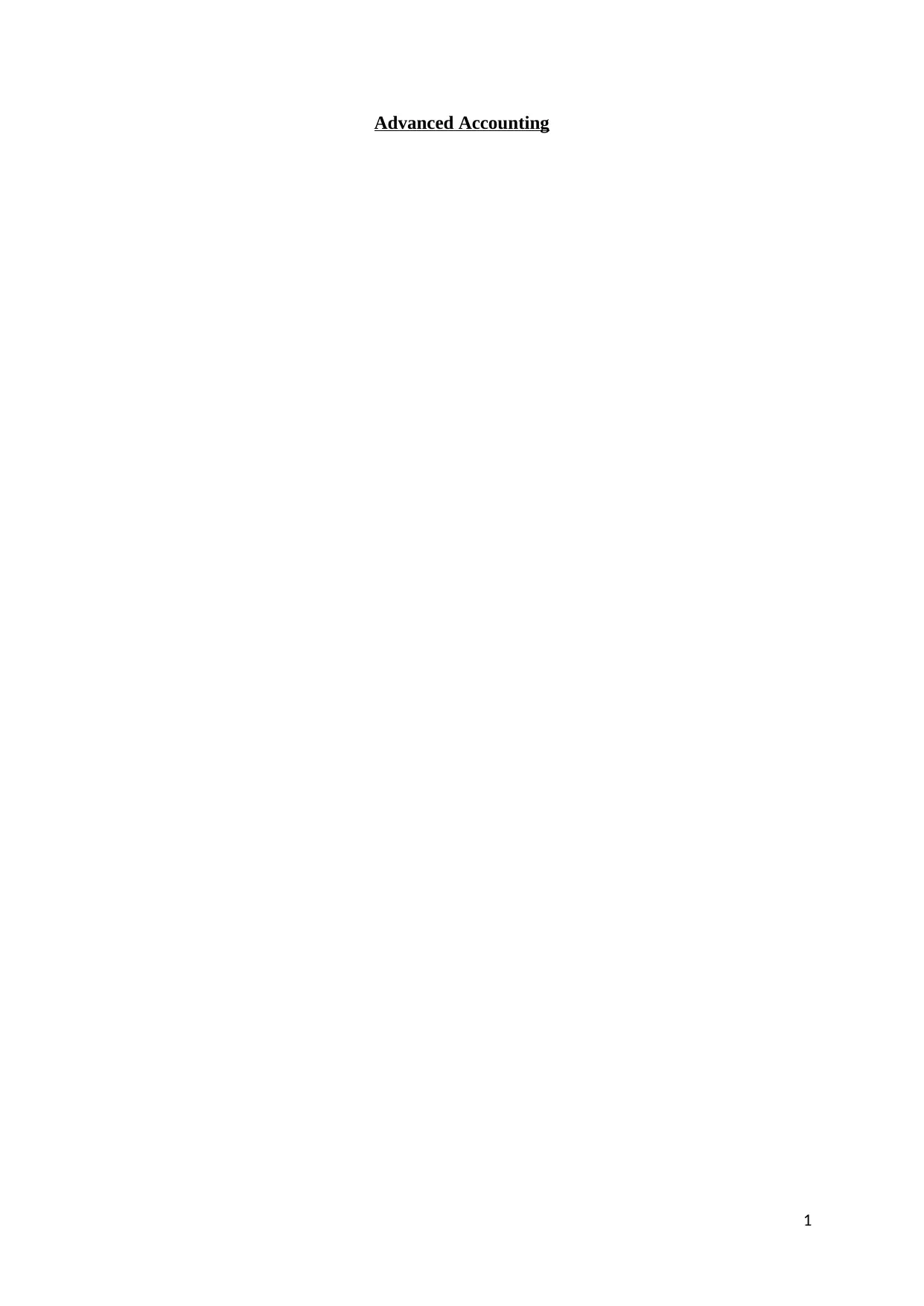
Advanced Accounting
1
1
Paraphrase This Document
Need a fresh take? Get an instant paraphrase of this document with our AI Paraphraser
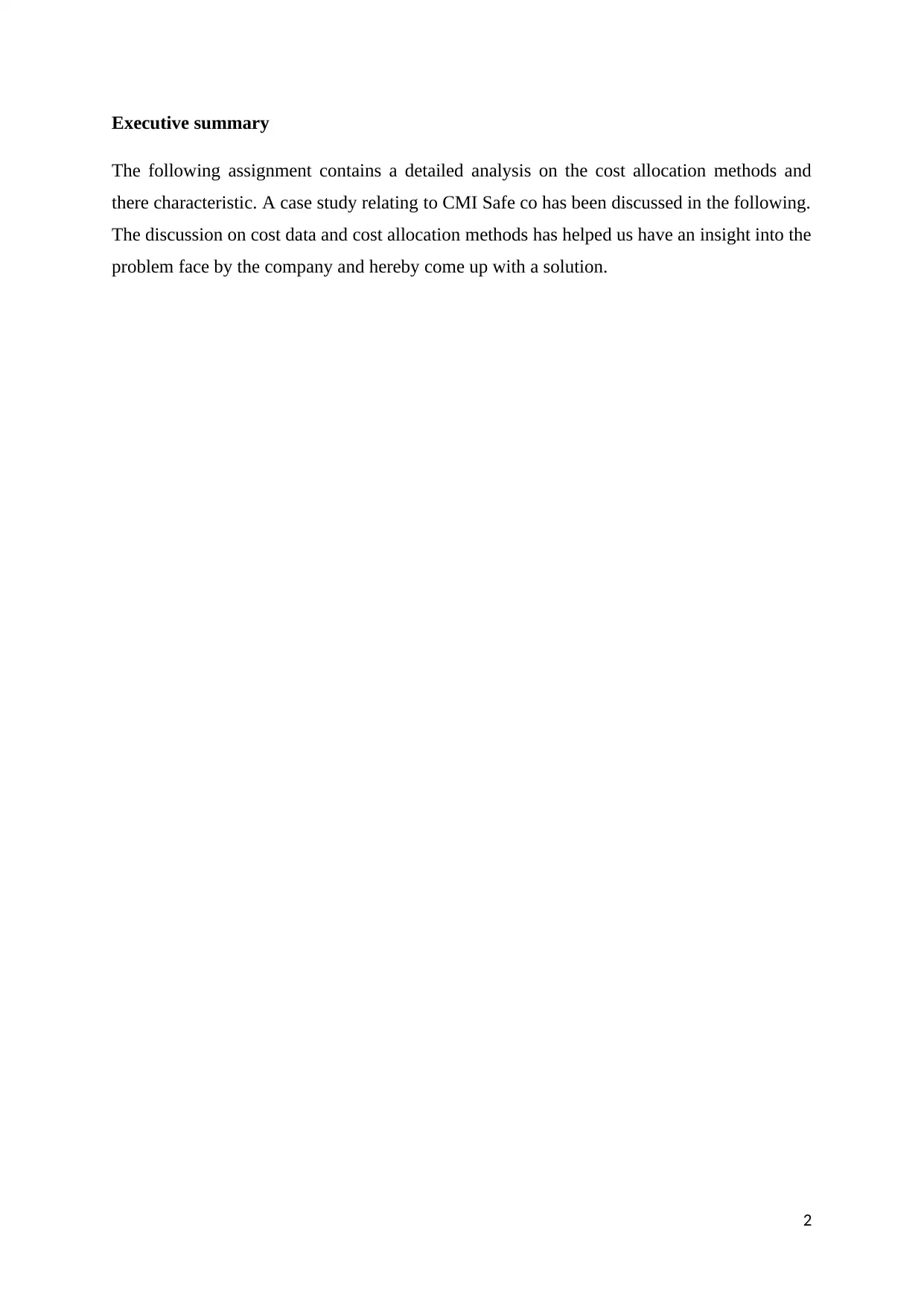
Executive summary
The following assignment contains a detailed analysis on the cost allocation methods and
there characteristic. A case study relating to CMI Safe co has been discussed in the following.
The discussion on cost data and cost allocation methods has helped us have an insight into the
problem face by the company and hereby come up with a solution.
2
The following assignment contains a detailed analysis on the cost allocation methods and
there characteristic. A case study relating to CMI Safe co has been discussed in the following.
The discussion on cost data and cost allocation methods has helped us have an insight into the
problem face by the company and hereby come up with a solution.
2
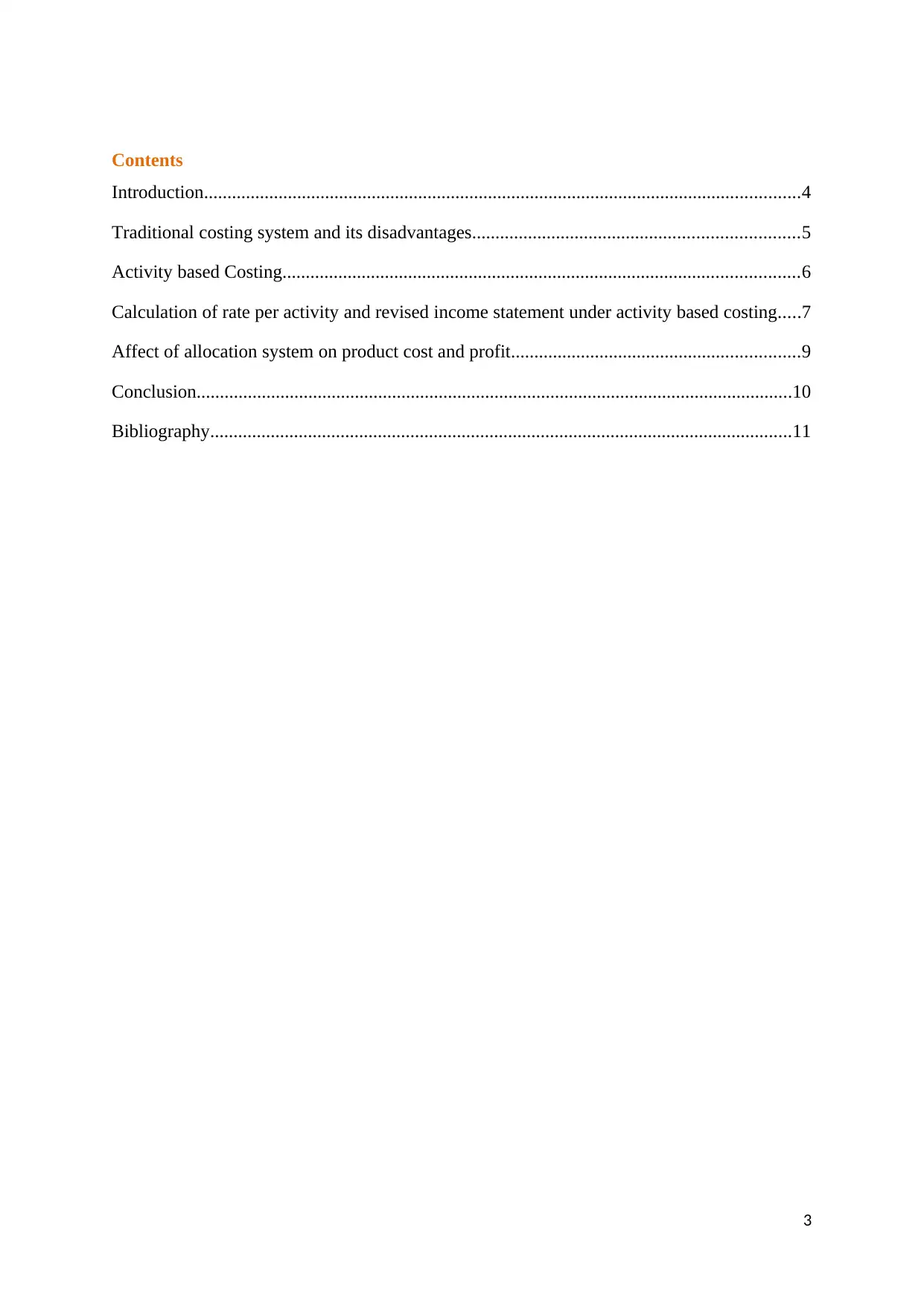
Contents
Introduction................................................................................................................................4
Traditional costing system and its disadvantages......................................................................5
Activity based Costing...............................................................................................................6
Calculation of rate per activity and revised income statement under activity based costing.....7
Affect of allocation system on product cost and profit..............................................................9
Conclusion................................................................................................................................10
Bibliography.............................................................................................................................11
3
Introduction................................................................................................................................4
Traditional costing system and its disadvantages......................................................................5
Activity based Costing...............................................................................................................6
Calculation of rate per activity and revised income statement under activity based costing.....7
Affect of allocation system on product cost and profit..............................................................9
Conclusion................................................................................................................................10
Bibliography.............................................................................................................................11
3
⊘ This is a preview!⊘
Do you want full access?
Subscribe today to unlock all pages.

Trusted by 1+ million students worldwide
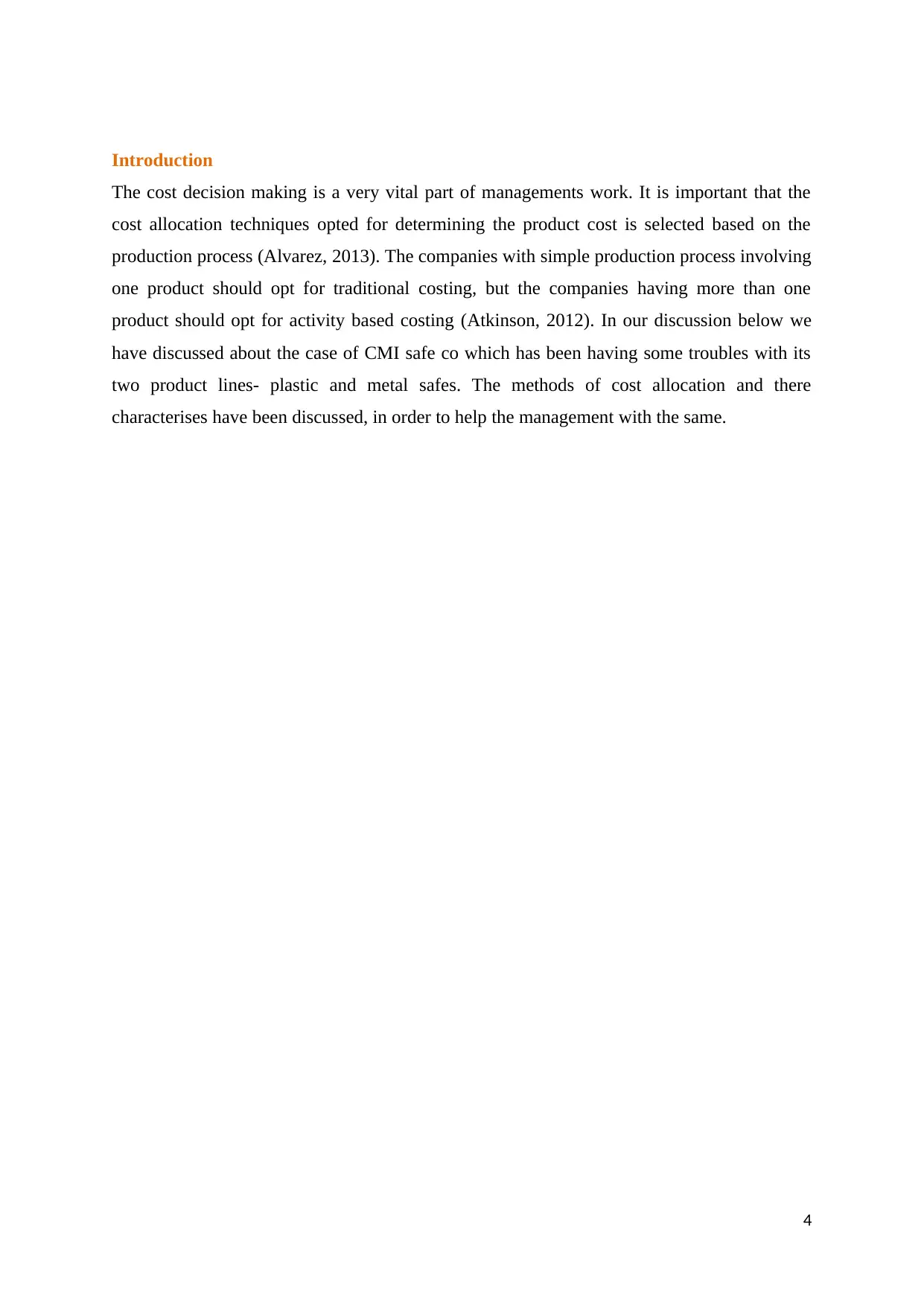
Introduction
The cost decision making is a very vital part of managements work. It is important that the
cost allocation techniques opted for determining the product cost is selected based on the
production process (Alvarez, 2013). The companies with simple production process involving
one product should opt for traditional costing, but the companies having more than one
product should opt for activity based costing (Atkinson, 2012). In our discussion below we
have discussed about the case of CMI safe co which has been having some troubles with its
two product lines- plastic and metal safes. The methods of cost allocation and there
characterises have been discussed, in order to help the management with the same.
4
The cost decision making is a very vital part of managements work. It is important that the
cost allocation techniques opted for determining the product cost is selected based on the
production process (Alvarez, 2013). The companies with simple production process involving
one product should opt for traditional costing, but the companies having more than one
product should opt for activity based costing (Atkinson, 2012). In our discussion below we
have discussed about the case of CMI safe co which has been having some troubles with its
two product lines- plastic and metal safes. The methods of cost allocation and there
characterises have been discussed, in order to help the management with the same.
4
Paraphrase This Document
Need a fresh take? Get an instant paraphrase of this document with our AI Paraphraser
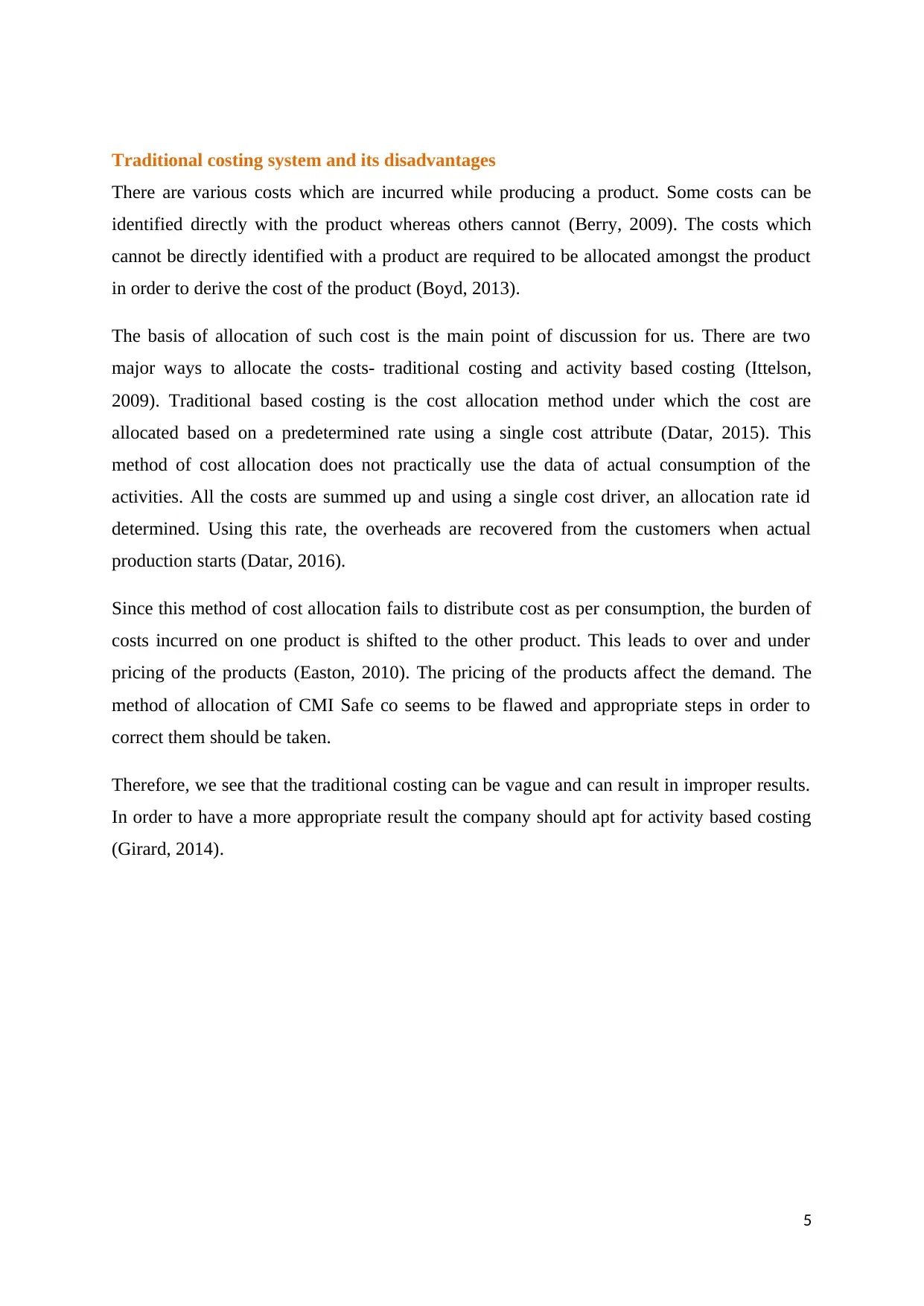
Traditional costing system and its disadvantages
There are various costs which are incurred while producing a product. Some costs can be
identified directly with the product whereas others cannot (Berry, 2009). The costs which
cannot be directly identified with a product are required to be allocated amongst the product
in order to derive the cost of the product (Boyd, 2013).
The basis of allocation of such cost is the main point of discussion for us. There are two
major ways to allocate the costs- traditional costing and activity based costing (Ittelson,
2009). Traditional based costing is the cost allocation method under which the cost are
allocated based on a predetermined rate using a single cost attribute (Datar, 2015). This
method of cost allocation does not practically use the data of actual consumption of the
activities. All the costs are summed up and using a single cost driver, an allocation rate id
determined. Using this rate, the overheads are recovered from the customers when actual
production starts (Datar, 2016).
Since this method of cost allocation fails to distribute cost as per consumption, the burden of
costs incurred on one product is shifted to the other product. This leads to over and under
pricing of the products (Easton, 2010). The pricing of the products affect the demand. The
method of allocation of CMI Safe co seems to be flawed and appropriate steps in order to
correct them should be taken.
Therefore, we see that the traditional costing can be vague and can result in improper results.
In order to have a more appropriate result the company should apt for activity based costing
(Girard, 2014).
5
There are various costs which are incurred while producing a product. Some costs can be
identified directly with the product whereas others cannot (Berry, 2009). The costs which
cannot be directly identified with a product are required to be allocated amongst the product
in order to derive the cost of the product (Boyd, 2013).
The basis of allocation of such cost is the main point of discussion for us. There are two
major ways to allocate the costs- traditional costing and activity based costing (Ittelson,
2009). Traditional based costing is the cost allocation method under which the cost are
allocated based on a predetermined rate using a single cost attribute (Datar, 2015). This
method of cost allocation does not practically use the data of actual consumption of the
activities. All the costs are summed up and using a single cost driver, an allocation rate id
determined. Using this rate, the overheads are recovered from the customers when actual
production starts (Datar, 2016).
Since this method of cost allocation fails to distribute cost as per consumption, the burden of
costs incurred on one product is shifted to the other product. This leads to over and under
pricing of the products (Easton, 2010). The pricing of the products affect the demand. The
method of allocation of CMI Safe co seems to be flawed and appropriate steps in order to
correct them should be taken.
Therefore, we see that the traditional costing can be vague and can result in improper results.
In order to have a more appropriate result the company should apt for activity based costing
(Girard, 2014).
5
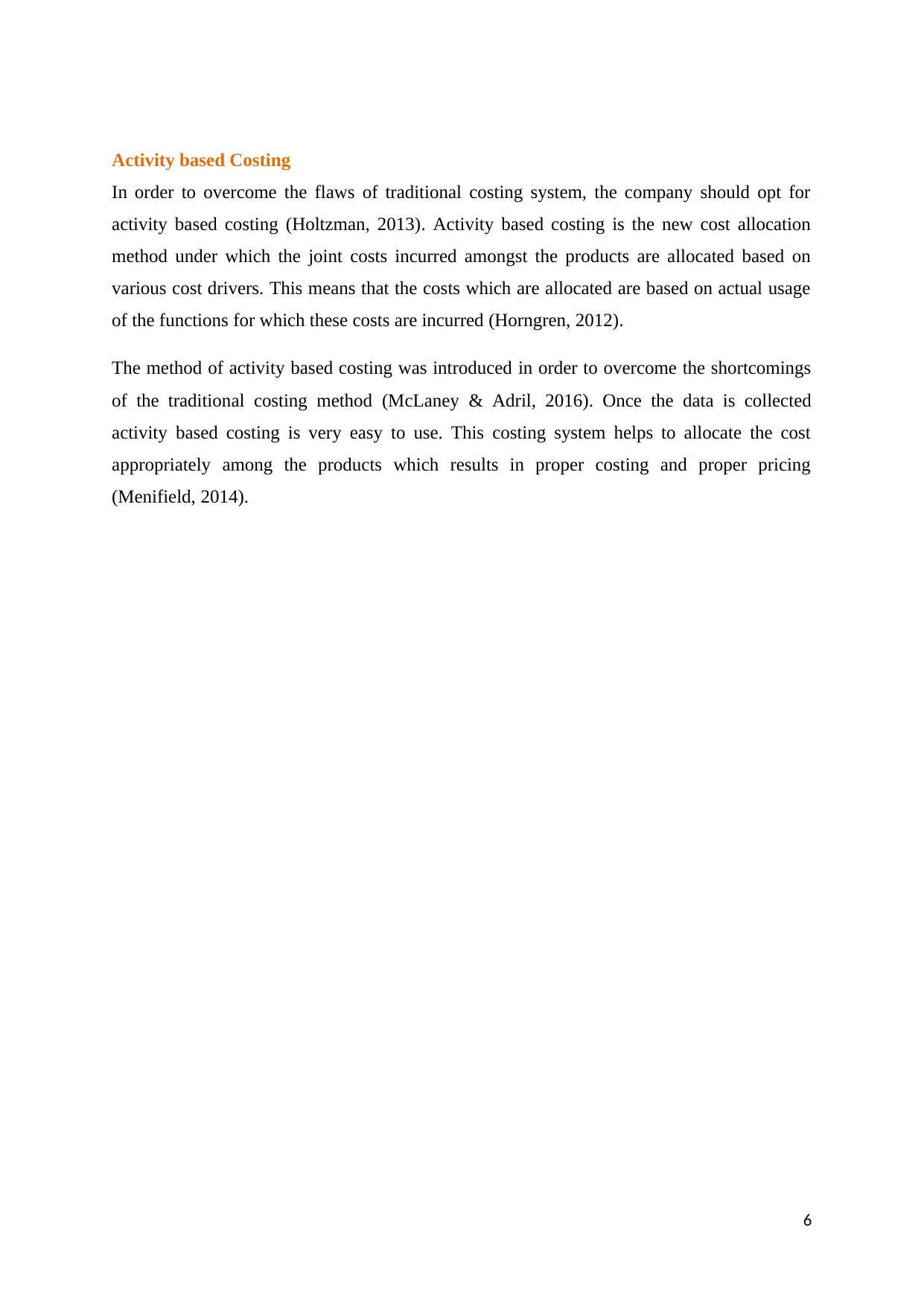
Activity based Costing
In order to overcome the flaws of traditional costing system, the company should opt for
activity based costing (Holtzman, 2013). Activity based costing is the new cost allocation
method under which the joint costs incurred amongst the products are allocated based on
various cost drivers. This means that the costs which are allocated are based on actual usage
of the functions for which these costs are incurred (Horngren, 2012).
The method of activity based costing was introduced in order to overcome the shortcomings
of the traditional costing method (McLaney & Adril, 2016). Once the data is collected
activity based costing is very easy to use. This costing system helps to allocate the cost
appropriately among the products which results in proper costing and proper pricing
(Menifield, 2014).
6
In order to overcome the flaws of traditional costing system, the company should opt for
activity based costing (Holtzman, 2013). Activity based costing is the new cost allocation
method under which the joint costs incurred amongst the products are allocated based on
various cost drivers. This means that the costs which are allocated are based on actual usage
of the functions for which these costs are incurred (Horngren, 2012).
The method of activity based costing was introduced in order to overcome the shortcomings
of the traditional costing method (McLaney & Adril, 2016). Once the data is collected
activity based costing is very easy to use. This costing system helps to allocate the cost
appropriately among the products which results in proper costing and proper pricing
(Menifield, 2014).
6
⊘ This is a preview!⊘
Do you want full access?
Subscribe today to unlock all pages.

Trusted by 1+ million students worldwide
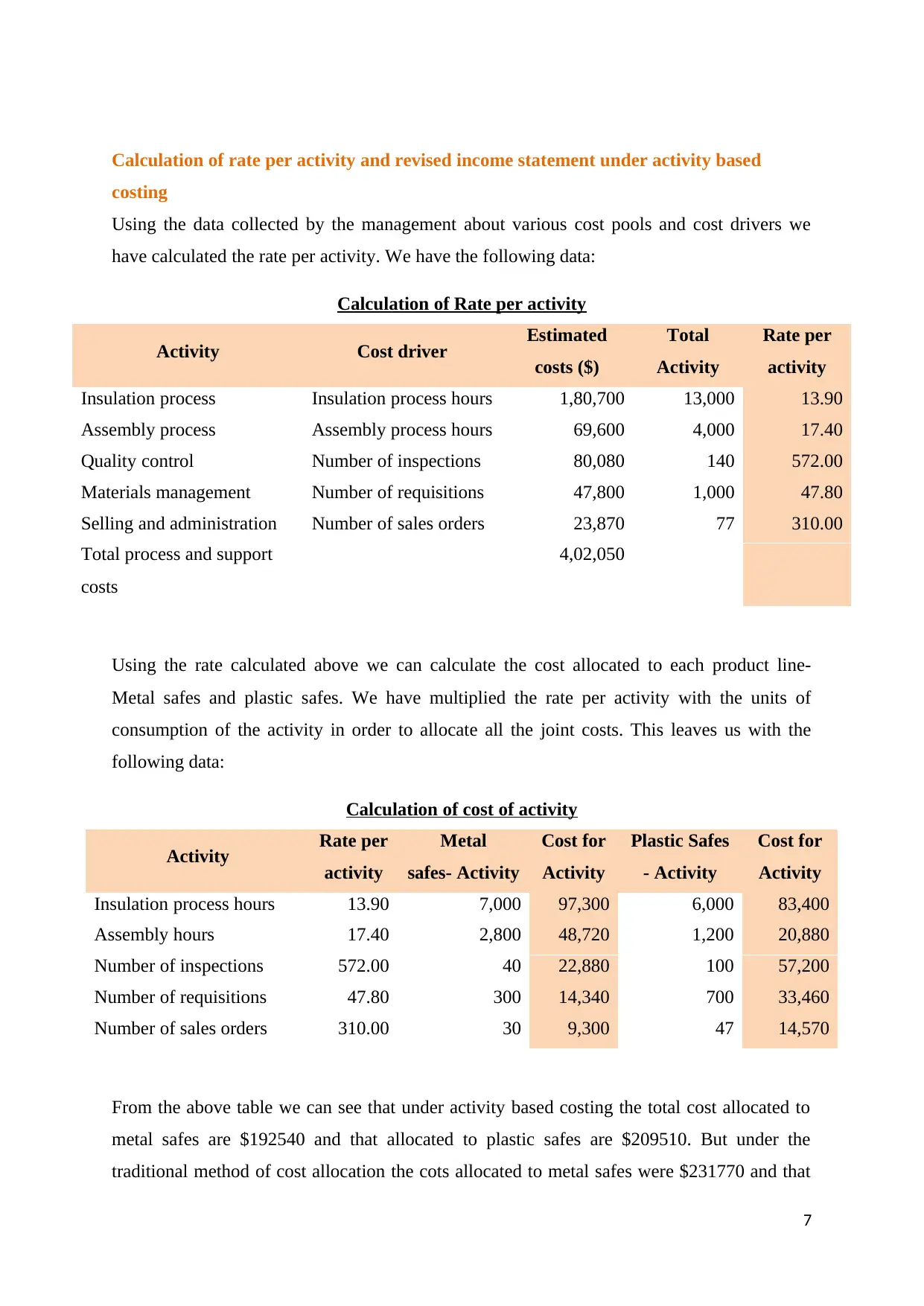
Calculation of rate per activity and revised income statement under activity based
costing
Using the data collected by the management about various cost pools and cost drivers we
have calculated the rate per activity. We have the following data:
Calculation of Rate per activity
Activity Cost driver Estimated
costs ($)
Total
Activity
Rate per
activity
Insulation process Insulation process hours 1,80,700 13,000 13.90
Assembly process Assembly process hours 69,600 4,000 17.40
Quality control Number of inspections 80,080 140 572.00
Materials management Number of requisitions 47,800 1,000 47.80
Selling and administration Number of sales orders 23,870 77 310.00
Total process and support
costs
4,02,050
Using the rate calculated above we can calculate the cost allocated to each product line-
Metal safes and plastic safes. We have multiplied the rate per activity with the units of
consumption of the activity in order to allocate all the joint costs. This leaves us with the
following data:
Calculation of cost of activity
Activity Rate per
activity
Metal
safes- Activity
Cost for
Activity
Plastic Safes
- Activity
Cost for
Activity
Insulation process hours 13.90 7,000 97,300 6,000 83,400
Assembly hours 17.40 2,800 48,720 1,200 20,880
Number of inspections 572.00 40 22,880 100 57,200
Number of requisitions 47.80 300 14,340 700 33,460
Number of sales orders 310.00 30 9,300 47 14,570
From the above table we can see that under activity based costing the total cost allocated to
metal safes are $192540 and that allocated to plastic safes are $209510. But under the
traditional method of cost allocation the cots allocated to metal safes were $231770 and that
7
costing
Using the data collected by the management about various cost pools and cost drivers we
have calculated the rate per activity. We have the following data:
Calculation of Rate per activity
Activity Cost driver Estimated
costs ($)
Total
Activity
Rate per
activity
Insulation process Insulation process hours 1,80,700 13,000 13.90
Assembly process Assembly process hours 69,600 4,000 17.40
Quality control Number of inspections 80,080 140 572.00
Materials management Number of requisitions 47,800 1,000 47.80
Selling and administration Number of sales orders 23,870 77 310.00
Total process and support
costs
4,02,050
Using the rate calculated above we can calculate the cost allocated to each product line-
Metal safes and plastic safes. We have multiplied the rate per activity with the units of
consumption of the activity in order to allocate all the joint costs. This leaves us with the
following data:
Calculation of cost of activity
Activity Rate per
activity
Metal
safes- Activity
Cost for
Activity
Plastic Safes
- Activity
Cost for
Activity
Insulation process hours 13.90 7,000 97,300 6,000 83,400
Assembly hours 17.40 2,800 48,720 1,200 20,880
Number of inspections 572.00 40 22,880 100 57,200
Number of requisitions 47.80 300 14,340 700 33,460
Number of sales orders 310.00 30 9,300 47 14,570
From the above table we can see that under activity based costing the total cost allocated to
metal safes are $192540 and that allocated to plastic safes are $209510. But under the
traditional method of cost allocation the cots allocated to metal safes were $231770 and that
7
Paraphrase This Document
Need a fresh take? Get an instant paraphrase of this document with our AI Paraphraser
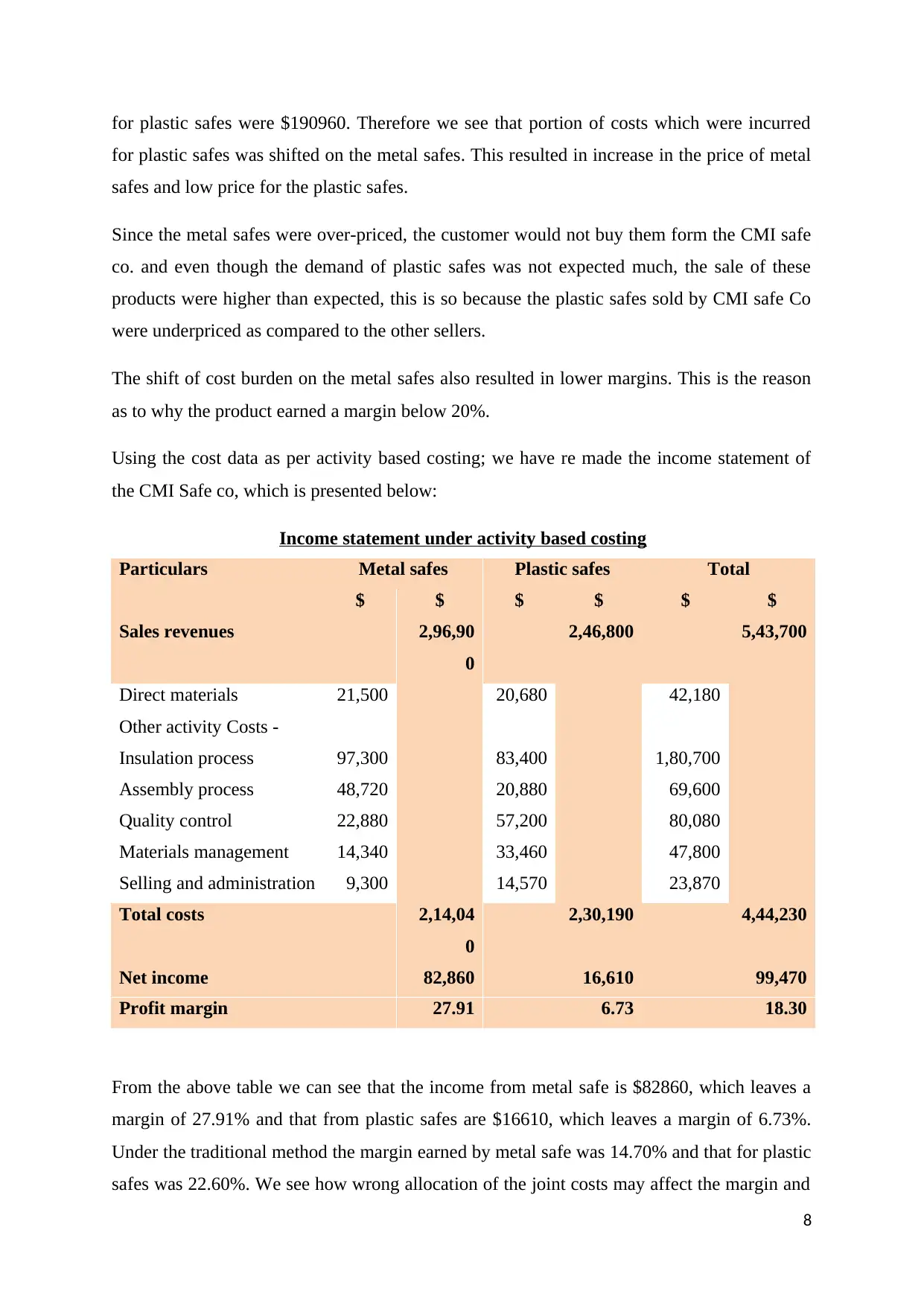
for plastic safes were $190960. Therefore we see that portion of costs which were incurred
for plastic safes was shifted on the metal safes. This resulted in increase in the price of metal
safes and low price for the plastic safes.
Since the metal safes were over-priced, the customer would not buy them form the CMI safe
co. and even though the demand of plastic safes was not expected much, the sale of these
products were higher than expected, this is so because the plastic safes sold by CMI safe Co
were underpriced as compared to the other sellers.
The shift of cost burden on the metal safes also resulted in lower margins. This is the reason
as to why the product earned a margin below 20%.
Using the cost data as per activity based costing; we have re made the income statement of
the CMI Safe co, which is presented below:
Income statement under activity based costing
Particulars Metal safes Plastic safes Total
$ $ $ $ $ $
Sales revenues 2,96,90
0
2,46,800 5,43,700
Direct materials 21,500 20,680 42,180
Other activity Costs -
Insulation process 97,300 83,400 1,80,700
Assembly process 48,720 20,880 69,600
Quality control 22,880 57,200 80,080
Materials management 14,340 33,460 47,800
Selling and administration 9,300 14,570 23,870
Total costs 2,14,04
0
2,30,190 4,44,230
Net income 82,860 16,610 99,470
Profit margin 27.91 6.73 18.30
From the above table we can see that the income from metal safe is $82860, which leaves a
margin of 27.91% and that from plastic safes are $16610, which leaves a margin of 6.73%.
Under the traditional method the margin earned by metal safe was 14.70% and that for plastic
safes was 22.60%. We see how wrong allocation of the joint costs may affect the margin and
8
for plastic safes was shifted on the metal safes. This resulted in increase in the price of metal
safes and low price for the plastic safes.
Since the metal safes were over-priced, the customer would not buy them form the CMI safe
co. and even though the demand of plastic safes was not expected much, the sale of these
products were higher than expected, this is so because the plastic safes sold by CMI safe Co
were underpriced as compared to the other sellers.
The shift of cost burden on the metal safes also resulted in lower margins. This is the reason
as to why the product earned a margin below 20%.
Using the cost data as per activity based costing; we have re made the income statement of
the CMI Safe co, which is presented below:
Income statement under activity based costing
Particulars Metal safes Plastic safes Total
$ $ $ $ $ $
Sales revenues 2,96,90
0
2,46,800 5,43,700
Direct materials 21,500 20,680 42,180
Other activity Costs -
Insulation process 97,300 83,400 1,80,700
Assembly process 48,720 20,880 69,600
Quality control 22,880 57,200 80,080
Materials management 14,340 33,460 47,800
Selling and administration 9,300 14,570 23,870
Total costs 2,14,04
0
2,30,190 4,44,230
Net income 82,860 16,610 99,470
Profit margin 27.91 6.73 18.30
From the above table we can see that the income from metal safe is $82860, which leaves a
margin of 27.91% and that from plastic safes are $16610, which leaves a margin of 6.73%.
Under the traditional method the margin earned by metal safe was 14.70% and that for plastic
safes was 22.60%. We see how wrong allocation of the joint costs may affect the margin and
8
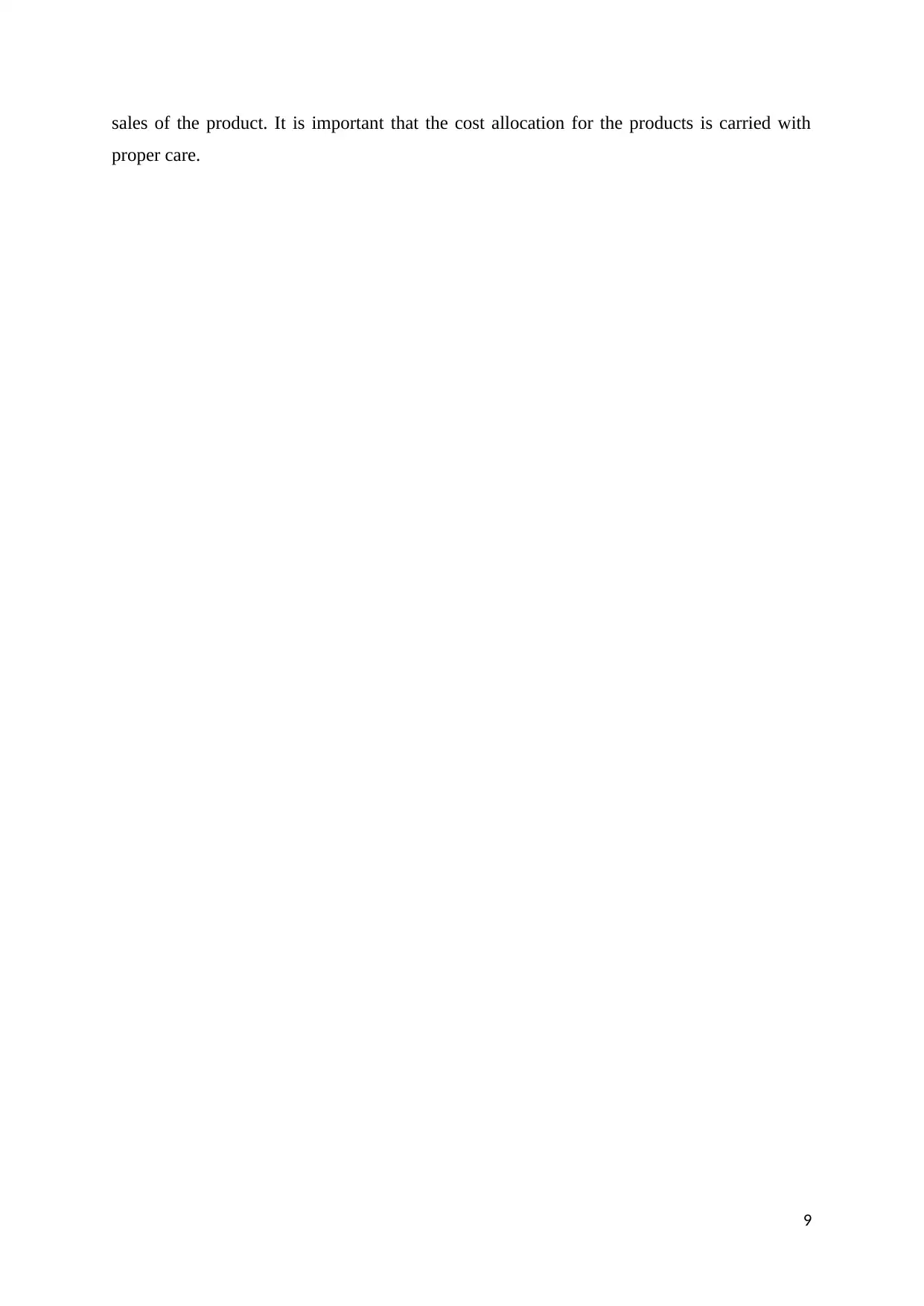
sales of the product. It is important that the cost allocation for the products is carried with
proper care.
9
proper care.
9
⊘ This is a preview!⊘
Do you want full access?
Subscribe today to unlock all pages.

Trusted by 1+ million students worldwide
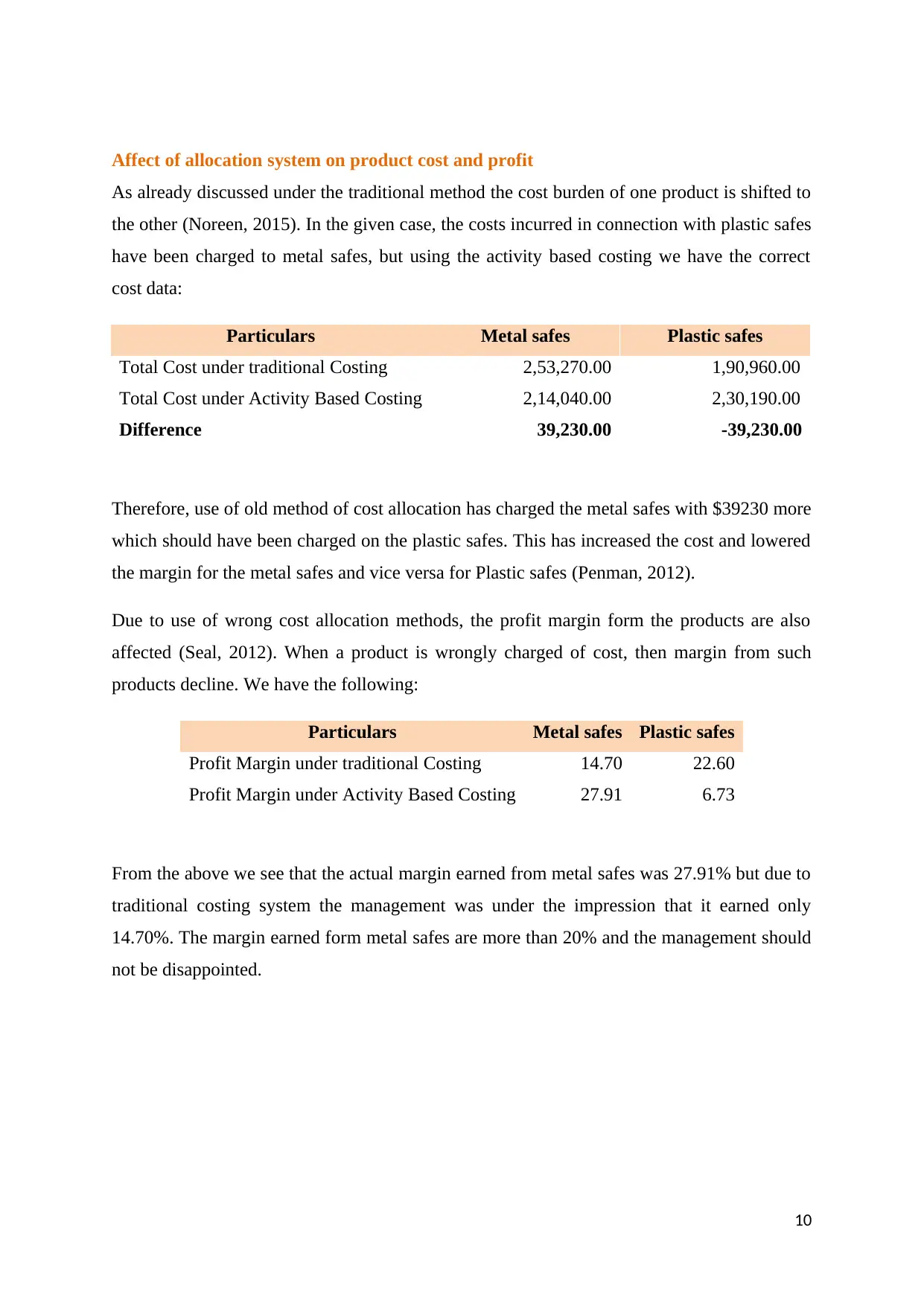
Affect of allocation system on product cost and profit
As already discussed under the traditional method the cost burden of one product is shifted to
the other (Noreen, 2015). In the given case, the costs incurred in connection with plastic safes
have been charged to metal safes, but using the activity based costing we have the correct
cost data:
Particulars Metal safes Plastic safes
Total Cost under traditional Costing 2,53,270.00 1,90,960.00
Total Cost under Activity Based Costing 2,14,040.00 2,30,190.00
Difference 39,230.00 -39,230.00
Therefore, use of old method of cost allocation has charged the metal safes with $39230 more
which should have been charged on the plastic safes. This has increased the cost and lowered
the margin for the metal safes and vice versa for Plastic safes (Penman, 2012).
Due to use of wrong cost allocation methods, the profit margin form the products are also
affected (Seal, 2012). When a product is wrongly charged of cost, then margin from such
products decline. We have the following:
Particulars Metal safes Plastic safes
Profit Margin under traditional Costing 14.70 22.60
Profit Margin under Activity Based Costing 27.91 6.73
From the above we see that the actual margin earned from metal safes was 27.91% but due to
traditional costing system the management was under the impression that it earned only
14.70%. The margin earned form metal safes are more than 20% and the management should
not be disappointed.
10
As already discussed under the traditional method the cost burden of one product is shifted to
the other (Noreen, 2015). In the given case, the costs incurred in connection with plastic safes
have been charged to metal safes, but using the activity based costing we have the correct
cost data:
Particulars Metal safes Plastic safes
Total Cost under traditional Costing 2,53,270.00 1,90,960.00
Total Cost under Activity Based Costing 2,14,040.00 2,30,190.00
Difference 39,230.00 -39,230.00
Therefore, use of old method of cost allocation has charged the metal safes with $39230 more
which should have been charged on the plastic safes. This has increased the cost and lowered
the margin for the metal safes and vice versa for Plastic safes (Penman, 2012).
Due to use of wrong cost allocation methods, the profit margin form the products are also
affected (Seal, 2012). When a product is wrongly charged of cost, then margin from such
products decline. We have the following:
Particulars Metal safes Plastic safes
Profit Margin under traditional Costing 14.70 22.60
Profit Margin under Activity Based Costing 27.91 6.73
From the above we see that the actual margin earned from metal safes was 27.91% but due to
traditional costing system the management was under the impression that it earned only
14.70%. The margin earned form metal safes are more than 20% and the management should
not be disappointed.
10
Paraphrase This Document
Need a fresh take? Get an instant paraphrase of this document with our AI Paraphraser
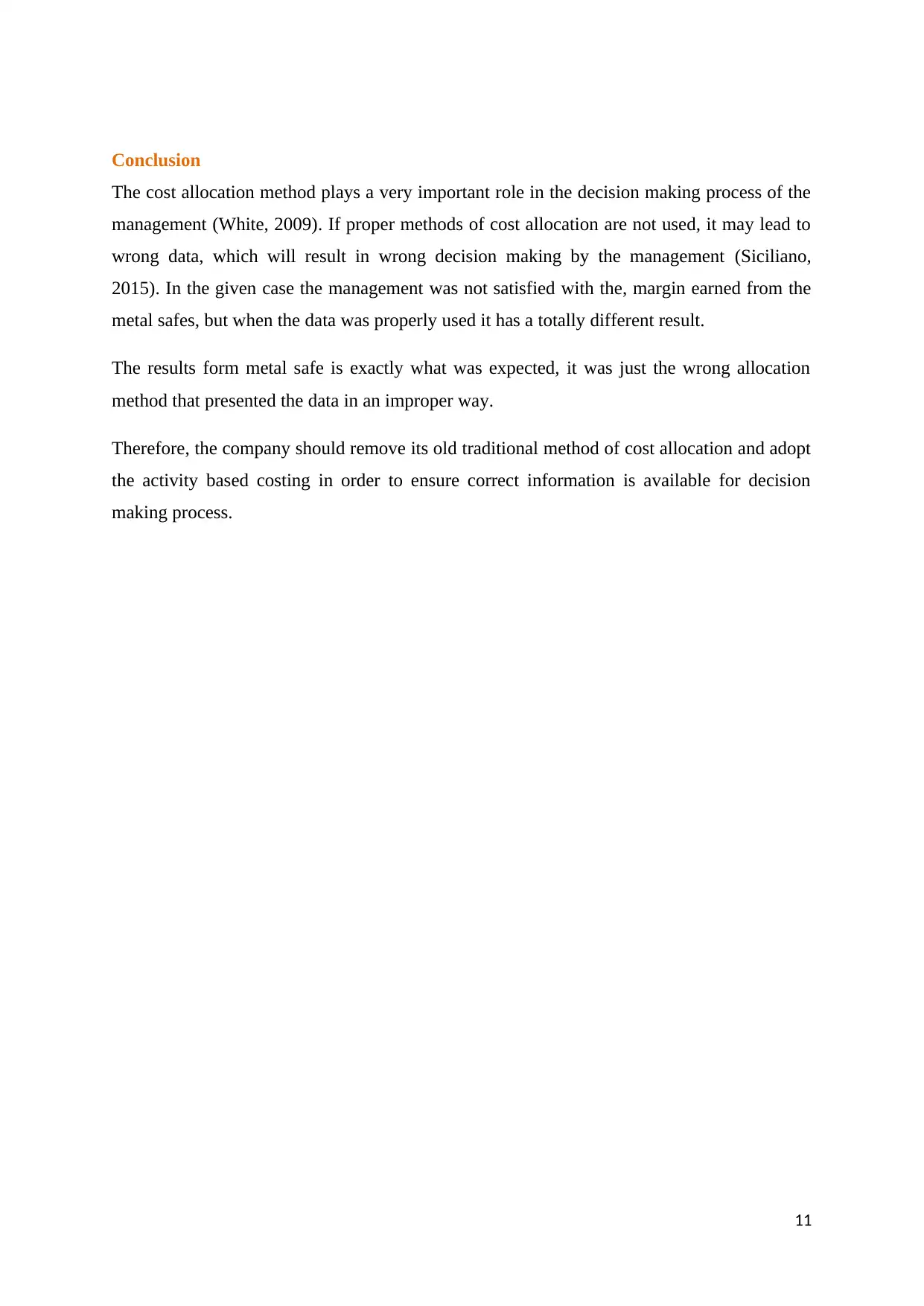
Conclusion
The cost allocation method plays a very important role in the decision making process of the
management (White, 2009). If proper methods of cost allocation are not used, it may lead to
wrong data, which will result in wrong decision making by the management (Siciliano,
2015). In the given case the management was not satisfied with the, margin earned from the
metal safes, but when the data was properly used it has a totally different result.
The results form metal safe is exactly what was expected, it was just the wrong allocation
method that presented the data in an improper way.
Therefore, the company should remove its old traditional method of cost allocation and adopt
the activity based costing in order to ensure correct information is available for decision
making process.
11
The cost allocation method plays a very important role in the decision making process of the
management (White, 2009). If proper methods of cost allocation are not used, it may lead to
wrong data, which will result in wrong decision making by the management (Siciliano,
2015). In the given case the management was not satisfied with the, margin earned from the
metal safes, but when the data was properly used it has a totally different result.
The results form metal safe is exactly what was expected, it was just the wrong allocation
method that presented the data in an improper way.
Therefore, the company should remove its old traditional method of cost allocation and adopt
the activity based costing in order to ensure correct information is available for decision
making process.
11
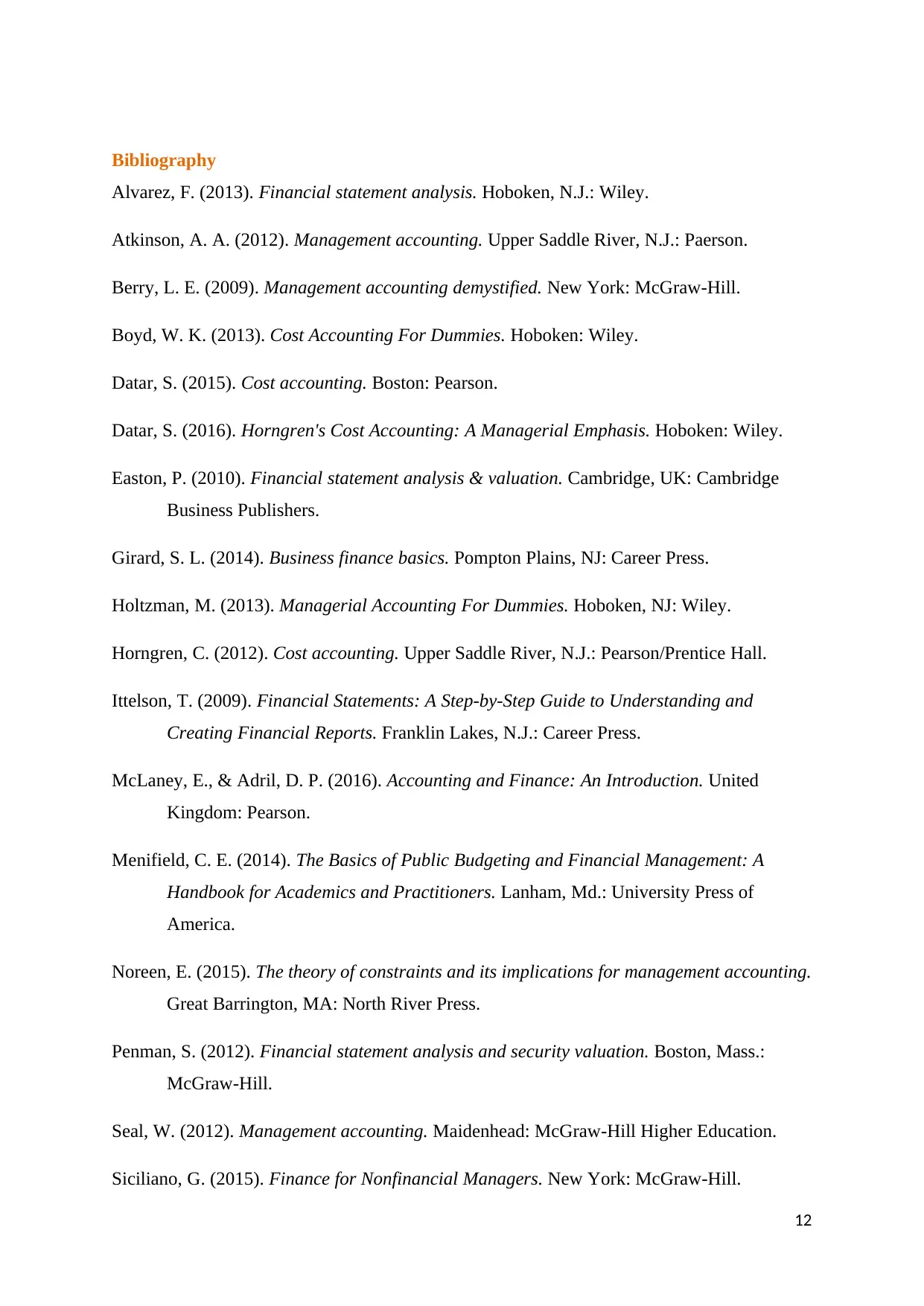
Bibliography
Alvarez, F. (2013). Financial statement analysis. Hoboken, N.J.: Wiley.
Atkinson, A. A. (2012). Management accounting. Upper Saddle River, N.J.: Paerson.
Berry, L. E. (2009). Management accounting demystified. New York: McGraw-Hill.
Boyd, W. K. (2013). Cost Accounting For Dummies. Hoboken: Wiley.
Datar, S. (2015). Cost accounting. Boston: Pearson.
Datar, S. (2016). Horngren's Cost Accounting: A Managerial Emphasis. Hoboken: Wiley.
Easton, P. (2010). Financial statement analysis & valuation. Cambridge, UK: Cambridge
Business Publishers.
Girard, S. L. (2014). Business finance basics. Pompton Plains, NJ: Career Press.
Holtzman, M. (2013). Managerial Accounting For Dummies. Hoboken, NJ: Wiley.
Horngren, C. (2012). Cost accounting. Upper Saddle River, N.J.: Pearson/Prentice Hall.
Ittelson, T. (2009). Financial Statements: A Step-by-Step Guide to Understanding and
Creating Financial Reports. Franklin Lakes, N.J.: Career Press.
McLaney, E., & Adril, D. P. (2016). Accounting and Finance: An Introduction. United
Kingdom: Pearson.
Menifield, C. E. (2014). The Basics of Public Budgeting and Financial Management: A
Handbook for Academics and Practitioners. Lanham, Md.: University Press of
America.
Noreen, E. (2015). The theory of constraints and its implications for management accounting.
Great Barrington, MA: North River Press.
Penman, S. (2012). Financial statement analysis and security valuation. Boston, Mass.:
McGraw-Hill.
Seal, W. (2012). Management accounting. Maidenhead: McGraw-Hill Higher Education.
Siciliano, G. (2015). Finance for Nonfinancial Managers. New York: McGraw-Hill.
12
Alvarez, F. (2013). Financial statement analysis. Hoboken, N.J.: Wiley.
Atkinson, A. A. (2012). Management accounting. Upper Saddle River, N.J.: Paerson.
Berry, L. E. (2009). Management accounting demystified. New York: McGraw-Hill.
Boyd, W. K. (2013). Cost Accounting For Dummies. Hoboken: Wiley.
Datar, S. (2015). Cost accounting. Boston: Pearson.
Datar, S. (2016). Horngren's Cost Accounting: A Managerial Emphasis. Hoboken: Wiley.
Easton, P. (2010). Financial statement analysis & valuation. Cambridge, UK: Cambridge
Business Publishers.
Girard, S. L. (2014). Business finance basics. Pompton Plains, NJ: Career Press.
Holtzman, M. (2013). Managerial Accounting For Dummies. Hoboken, NJ: Wiley.
Horngren, C. (2012). Cost accounting. Upper Saddle River, N.J.: Pearson/Prentice Hall.
Ittelson, T. (2009). Financial Statements: A Step-by-Step Guide to Understanding and
Creating Financial Reports. Franklin Lakes, N.J.: Career Press.
McLaney, E., & Adril, D. P. (2016). Accounting and Finance: An Introduction. United
Kingdom: Pearson.
Menifield, C. E. (2014). The Basics of Public Budgeting and Financial Management: A
Handbook for Academics and Practitioners. Lanham, Md.: University Press of
America.
Noreen, E. (2015). The theory of constraints and its implications for management accounting.
Great Barrington, MA: North River Press.
Penman, S. (2012). Financial statement analysis and security valuation. Boston, Mass.:
McGraw-Hill.
Seal, W. (2012). Management accounting. Maidenhead: McGraw-Hill Higher Education.
Siciliano, G. (2015). Finance for Nonfinancial Managers. New York: McGraw-Hill.
12
⊘ This is a preview!⊘
Do you want full access?
Subscribe today to unlock all pages.

Trusted by 1+ million students worldwide
1 out of 13
Related Documents
Your All-in-One AI-Powered Toolkit for Academic Success.
+13062052269
info@desklib.com
Available 24*7 on WhatsApp / Email
![[object Object]](/_next/static/media/star-bottom.7253800d.svg)
Unlock your academic potential
Copyright © 2020–2025 A2Z Services. All Rights Reserved. Developed and managed by ZUCOL.




